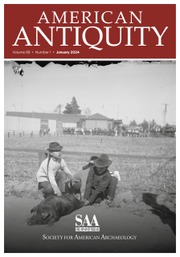Article contents
Pre-Clovis Lithic Technology at the Debra L. Friedkin Site, Texas: Comparisons to Clovis through Site-Level Behavior, Technological Trait-List, and Cladistic Analyses
Published online by Cambridge University Press: 20 January 2017
Abstract
Humans first left Siberia and colonized the Americas perhaps around 16,000 years ago, and the Clovis archaeological complex in North America has traditionally been linked to this migratory pulse. Archaeologists searching for evidence of Clovis technological antecedents have focused their attention on the Beringian and Siberian archaeological records. Growing evidence for the pre-Clovis occupation of North America provides a possible alternative source for the origins of Clovis. In this paper, we present new data on the pre-Clovis lithic assemblage from the Debra L. Friedkin site, Texas, and compare Clovis and pre-Clovis lithic technological signatures. We show that while Clovis and pre-Clovis share some important technological traits, they also differ in important ways. We conclude that the pre-Clovis assemblage from Debra L. Friedkin cannot be called “Clovis,” but it could represent a technological antecedent of Clovis.
Resumen
Los seres humanos primero dejaron de Siberia y colonizaron América quizás alrededor de 16,000 años, y el complejo arqueológico de Clovis en América del norte, tradicionalmente se ha relacionado con este pulso migratoria. Arqueólogos buscando evidencia de Clovis antecedentes tecnologicos han centrado su atención en los registros arqueológicos Beringian y Siberianos. Creciente evidencia de la ocupación de pre-Clovis de América del norte proporciona unafuente alternativa posible para los orígenes de Clovis. En este trabajo presentamos nuevos datos sobre el conjunto lítíco de pre-Clovis del sitio de Debra L. Friedkin, Texas y compara Clovis y firmas tecnológícas lítícas de pre-Clovis. Nos muestran que mientras que Clovis y pre-Clovis comparten algunas características tecnológicas importantes, también difieren en aspectos importantes. Concluimos que el conjunto de pre-Clovis de Debra L. Friedkin no puede llamarse “Clovis,” pero podria representor un antecedente tecnológico de Clovis.
Information
- Type
- Articles
- Information
- Copyright
- Copyright © The Society for American Archaeology 2014
References
References Cited
- 53
- Cited by

